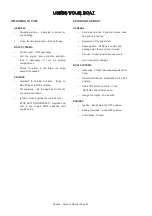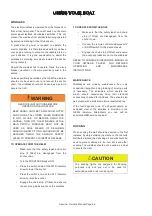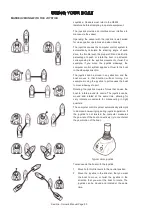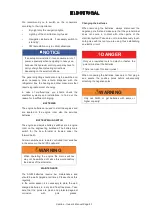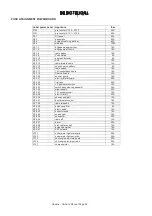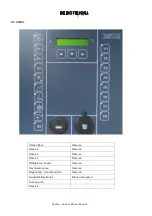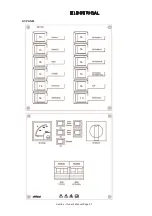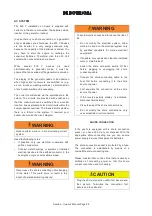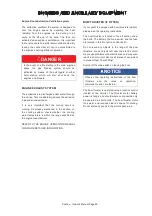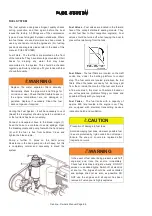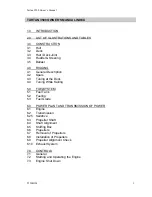
(/(&75,&$/
6HDOLQH2ZQHUV0DQXDO3DJH
ELECTRICAL SYSTEM
The yacht is equipped with an electrical system with
12V direct current (DC) and a 230V alternating current
(AC) system.
Do not modify the craft’s electrical systems or relevant
drawings. Installation, alterations and maintenance
should be performed by a competent marine electrical
technician. Inspect the system at least biennially.
DANGER
Open the switchboards only when they are current
free, because you might contact live elements that
are not protected by fuses. There is a risk of
electric shock.
DANGER
There is a risk of fire and explosion when handling
electrical direct current (DC) and alternating
current (AC) systems in an improper manner.
Information on the scope and the equipment can be
found in the operating instructions and the contract
specification. Take note of the operating instructions
that include circuit diagrams for the electrical systems
and devices!
The electrical systems can be switched and controlled
via the respective main control panels.
DC SYSTEM
Batteries supply the current for the 12V installation on
board.
The direct current system is in charge of starting the
engine and supplying power to the navigation
instruments, the lighting and part of the electrical
equipment on board.
Distribution occurs via the distribution fuse panel
(Powerboard) in the engine room. If required, your
dealer can provide the circuit diagram.
The main switches for the engine batteries and service
batteries, the main fuses and additional fuses are
located in the engine room.
The power is distributed via the switchboard in the
saloon. The circuits have switches so that the
consumers can be switched on and off centrally. All
power circuits within the system must be protected
against overload by fuses. The fuses located on the DC
back side indicate whether there is a failure in the
system. The circuit diagram can be made available by
your dealer if required.
Pay attention because the battery capacity is restricted.
If the voltage is less than 10.5 Volt a recharging of the
batteries is necessary.
The essential circuits of the direct current consumers
are:
•
navigation lights
•
interior and deck lighting
•
electrical devices
•
220 V devices via inverters (according to the
contract specification)
The interior and deck lighting consists of energy-saving
halogen or fluorescent lamps and requires relatively little
power. The navigation electronics also require very little
power. Nevertheless, you should turn off the consumers
you no longer need as soon as possible. This can also
be done centrally from the main control panel.
Is it not possible to recharge the batteries you must
reduce the power consumption by switching off of not
necessary consumers. Nautical lighting has absolute
priority. In case a capacity bottleneck occurs due to a
failure in the supply, all other consumers must be
switched off first.
Summary of Contents for S450
Page 1: ... ...
Page 2: ... ...
Page 6: ... 6HDOLQH 2ZQHU V 0DQXDO 3DJH ...
Page 55: ... 75 6HDOLQH 2ZQHU V 0DQXDO 3DJH AC PANEL 10 10 16 10 16 16 16 16 16 10 16 10 ...
Page 81: ... 7 1 6HDOLQH 2ZQHU V 0DQXDO 3DJH ...
Page 82: ... 6HDOLQH 2ZQHU V 0DQXDO 3DJH DATA SHEETS DIAGRAMS PRINCIPAL DIMENSIONS ...
Page 84: ... 6HDOLQH 2ZQHU V 0DQXDO 3DJH DECK PLAN ...
Page 86: ... 6HDOLQH 2ZQHU V 0DQXDO 3DJH SYSTEM CONTROL POINTS ...
Page 88: ... 6HDOLQH 2ZQHU V 0DQXDO 3DJH EQUIPMENT LOCATION ACCOMMODATION SPACE ...
Page 90: ... 6HDOLQH 2ZQHU V 0DQXDO 3DJH GAS SYSTEM LAYOUT ...
Page 92: ... 6HDOLQH 2ZQHU V 0DQXDO 3DJH FIRE PROTECTION SYSTEM 3 4 1 5 6 8 1 2 7 8 8 1 ...
Page 94: ... 6HDOLQH 2ZQHU V 0DQXDO 3DJH BLACK WATER SYSTEM ...

